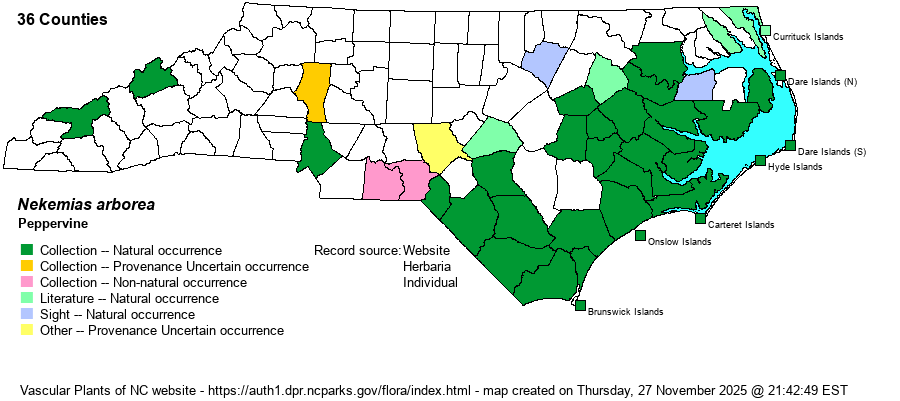| Author | (L.) J. Wen & Boggan | |
| Distribution | Present over most of the eastern and central Coastal Plain, but scarce in the upper part of the province, including the Sandhills region. A few widely scattered sites in the Piedmont and Mountains, limited to only a few counties (so far); sites in these provinces need to be carefully checked for provenance, however. Specimens collected from Scotland County in 2020 and Richmond County in 2021 and 2024 are from an old homesite and a disused schoolyard, respectively, and are considered non-natural occurrences (an old specimen from Scotland appears to be natural). Likewise, a specimen from Anson County in 2022 is considered non-native. There are numerous iNaturalist photos scattered over much of the Piedmont that are not mapped below owing to uncertainty of provenance.
This is a Southern species ranging from southeastern VA west to southeastern KS; south to the Gulf Coast of FL and southern TX. It is scarce away from the Atlantic and Gulf Coastal Plains.
| |
| Abundance | Common in much of the eastern half of the Coastal Plain, but infrequent in the upper (western) portions, and not known as a native from the Sandhills proper. Absent to very rare in the Piedmont and Mountains (where known from just Madison and Swain counties). | |
| Habitat | This is a species of rather rich, swampy or wet bottomland forests, maritime forests, and wet thickets and marshes. It is rare in strongly acidic wetlands (pocosins, bays, Sandhills streams and seepages, etc.). In non-native (adventive) settings, it occupies old homesites, disturbed woodlands, etc. | |
| Phenology | Blooms from June to October, and fruits shortly after blooming. | |
| Identification | This is a high-climbing, deciduous woody vine. It has distinctive alternate leaves, with each leaf being divided at least twice (and often three times) into small and strongly toothed leaflets about 1 inch long. The leaves have long petioles and average around 5-6 inches long. Tendrils may be present along the stem, but the plants climb essentially by the twining of the stems. The inflorescences consist of small greenish flowers in clusters along the stem, but the fruits –- blackish and round berries about 1/4-inch wide -– can be conspicuous. The primary source of confusion in identification is with Trumpet-creeper (Campsis radicans), which has leaves only singly-pinnate, and not doubly or triply branched as in Peppervine. | |
| Taxonomic Comments | In recent years, some references such as Weakley (2018) have moved this species out of Ampelopsis (leaving one other Southeastern native there) and placing it into Nekemias (as N. arborea). Ampelopsis has simple leaves.
| |
| Other Common Name(s) | None (other than spelling it with two words – Pepper Vine). Note that N. arborea is essentially always known as Peppervine, without a modifier name, such as Eastern Peppervine or Common Peppervine. This is a problematic name issue, allowing confusion with Heartleaf Peppervine (A. cordata), as both species use the word “Peppervine” in the common name. | |
| State Rank | S5 | |
| Global Rank | G5 | |
| State Status | | |
| US Status | | |
| USACE-agcp | | |
| USACE-emp | | |

